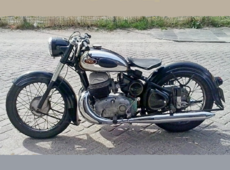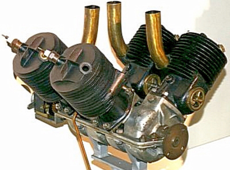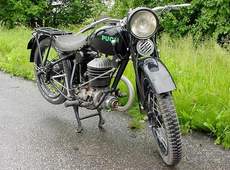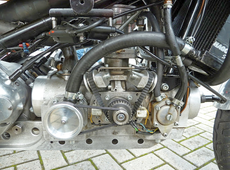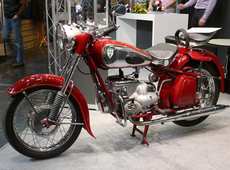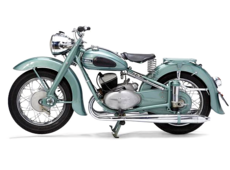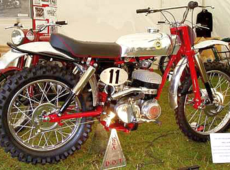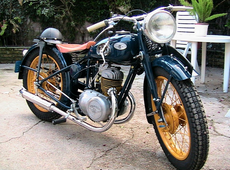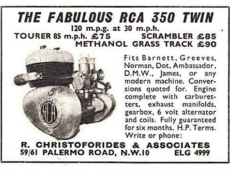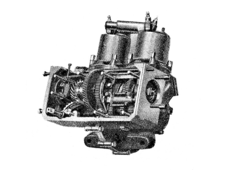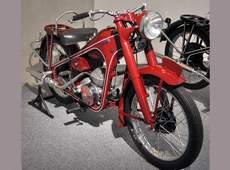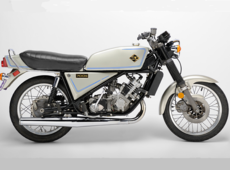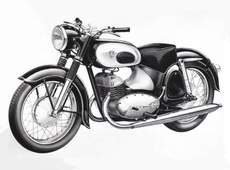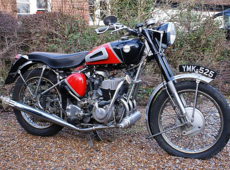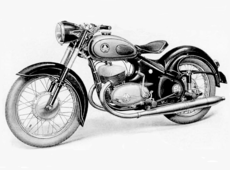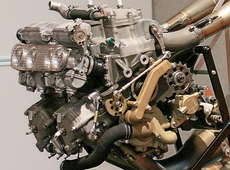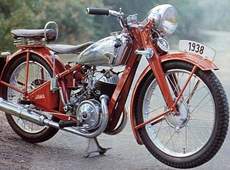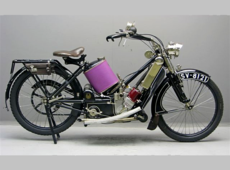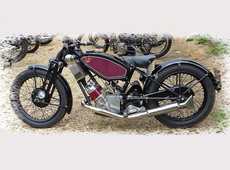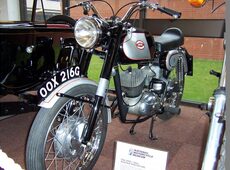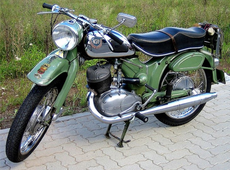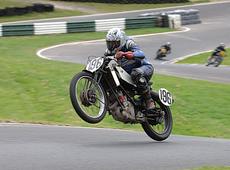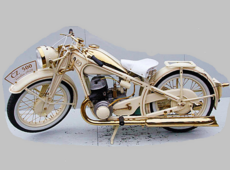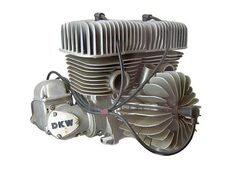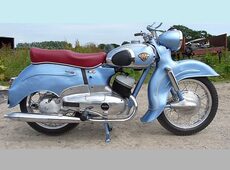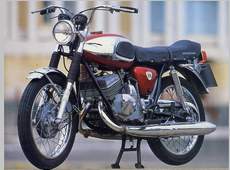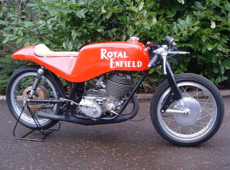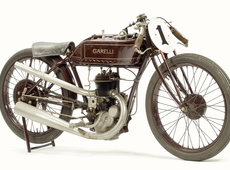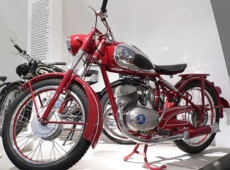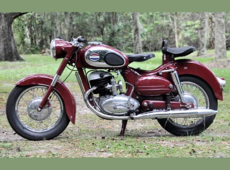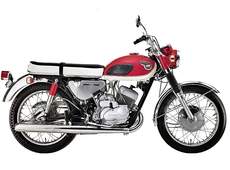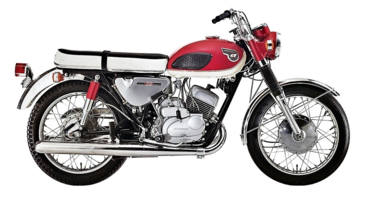
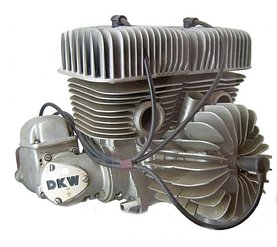
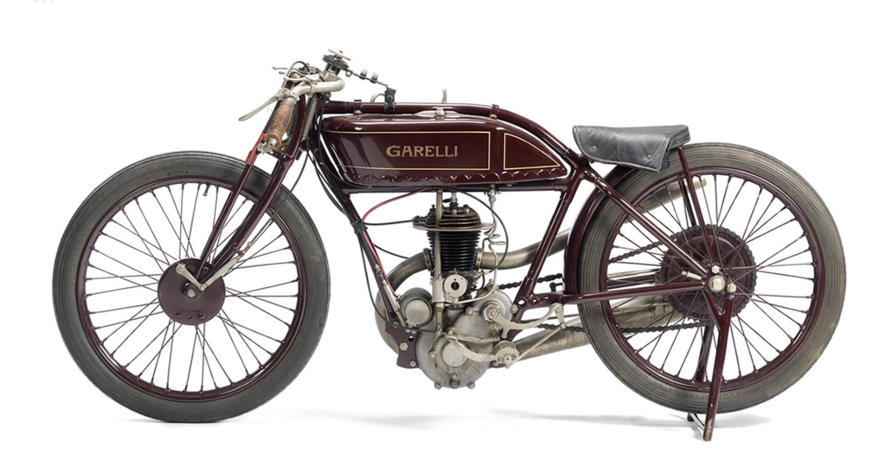
Work in progress
Two-stroke motorcycle history.
Silk Motorcycles 1975 - 1979 A British firm carried on from where Scott left off, together with new exciting developments.
The story of the Silk marque begins in the late 1960s, when George Silk a lifelong Scott motorcycle enthusiast and fellow Scott owner Maurice Patey a motorcycle engineer formed the Silk Engineering Company in Derby.
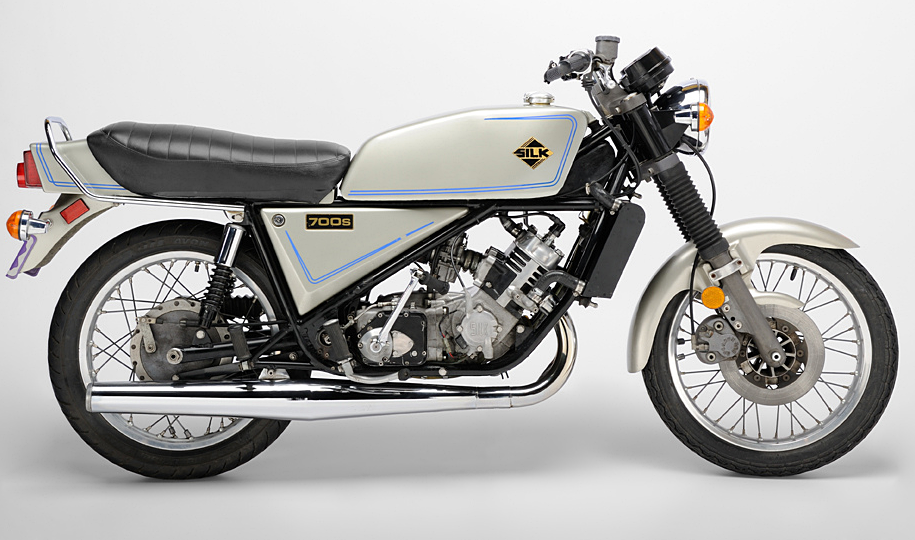
1978 Silk Sabre 700cc
George was a successful Scott racer and a tuner of Scott engines, it’s this racing involvement that was the embryo for the forthcoming motorcycle venture.
I approached Mr George Silk to further my knowledge on his motorcycles and he has been very helpful, hopefully this has now enabled me to correct the many inaccuracies that have previously been published elsewhere.
Their first Silk-Scott motorcycle came about by accident, literally.
A customer was in need of a new frame because his was damaged and asked for a road going version of the Silk Scott racer to be built for him, and this led to the first prototype being made.
Following an invite from Spondon’s Bob Stevenson, a prototype was displayed on their stand in London at the 1971 Racing and Sporting Motorcycle Show.
Following the Motorcycle Show many orders were taken, in fact there were more orders for bikes than would ever be built, each of which was unique as because of the hand built nature of this new motorcycle, owners could specify the exact specification of their machine, one was even fitted with a sidecar.
Unfortunately they couldn’t satisfy all of the Silk-Scott motorcycle orders because of delays when trying to find available Scott engines, they tried negotiating with Matt Holder, the Birmingham Scott manufacturer to buy 35 Scott engines or parts from him, but he wouldn’t sell.
From what I have read it might have been that Mr Holder Matt was a bit peeved ‘allegedly’ on finding the Scott name on the petrol tank, thus the market for Silk-Scott’s had been accidentally created but unfortunately there were now no Scott engines available.
Thus in 1973 the 700 Silk engine was evolved to overcome a shortage, this brand new two-stroke engine was designed by George and engineer Maurice Patey and within a year the complete Silk motorcycle made its debut. A motorcycle accidentally created because of the unobtainable Scott engine.
George had previously worked making components for vintage and racing Scott’s and not surprisingly the Silk motor had a distinct appearance to the old Scott two-stroke twin, but apart from deflector piston technology it was somewhat different.
The engine has a central duplex sprocket but each cylinder has a full circle flywheel pair, silver plated big end cages, modern deflector pistons with matching squish head. Other features were a throttled controlled oil pump, trouble free piston ring seals in the centre, a Renold designed primary drive and a Velocette inspired 4 speed bullet proof gearbox.
Lubrication was a 50:1 petroil mix and main bearing lubrication was throttle controlled from a large separate oil tank.
Like earlier Scotts the Silk used the unusual and simple thermosyphon cooling system, no water pump is required as it’s the engine heat that activates water circulation, a single 34mm Amal carb together with a two-into-one exhaust.
These engines were made before the CNC machining era, so to achieve the quality that they did with the limited funds was indeed an achievement.
The initial goal was to design and manufacture a simple but robust two-stroke twin with a target of 60,000 miles between major overhauls with one carburettor, one silencer, electronic ignition and a fully enclosed rear chain.
The frame was built by the nearby reputable Spondon company, a version of one of their racing frame’s but modified for street use.
Both George and Maurice had Scott Sprint Specials and they made the 700 in that mould, to be light and to steer like no other with an easy going motor. It was never the most powerful or never the fastest, but as a package it was in it’s element on the twisty roads of the Peak District.
The new engine used their own modern cross scavenging deflector piston technology, an improvement patent was granted for their cross flow scavenge work.
Most modern two-stroke engines use loop scavenging with it’s flat topped pistons and rely on multiport scavenging systems, the drawback with this system is that an unacceptable amount of the unburned fuel is pumped out of the exhaust, with the inevitable resulting high fuel consumption.
I was initially disappointed that they chose to use deflector pistons and did not pursue flat top piston technology, however they did have their reasons for continuing with deflector pistons, their aim was to make a more fuel efficient two-stroke.
The claim is that a more effective scavenging would take place without losing too much of the fresh charge out of the exhaust port, thus obtaining good power output with lower revs and much improved fuel consumption, as there is no reliance on high revs and the resulting excessive fuel consumption.
Maximum torque is at 3,000rpm and maximum power at around 6,000rpm and a four-speed gearbox is all that is needed.
In 1977 it was given a dealer network.
Dr Blair of Queens University Belfast chaired a Mechanical Engineering Conference on Two-Strokes and subsequently Silk And Co received the Gresham Cooke award from the Institute, this was for the very good work on their later 250/500s loop scavenge engines. They also had at that time a provisional patent for their boost ported cross flow engine.
The involvement with Queens University Belfast came about through the above connection and the result was that QUB designed the exhaust system. Two-stroke exhausts are tricky things to design, their length, shape and size are critical to ensure good scavenging and optimum performance.
A Sheffield colleague of Blair sorted out the silencer which featured a fairly unique inverted tailpipe (stinger).
Contrary to what you might have read in other publications the exhaust system was Blair’s only contribution with the Silk project.
Although the Silk 700 was their production base they were also busy exploring other projects.
A 500cc parallel twin engine was built during the 1980’s for a magazine prize and installed in a standard 700 frame, the owner at the time said it did 90 in 2nd! What this owner didn’t know is that it had to be detuned, because the first tests ripped the clutch and rear tyre to shreds.
A 328cc deflector piston engine trials motorcycle was produced followed by a complete non-deflector piston 250 version which still exists.
The 250 is a single cylinder, air or water cooled on a split half crankcase/gearbox 4 speed with a 2 speed rear axle and the operating concentric sprocket on the swinging arm pivot.
Silk also had a new flat top engine that they had developed in 250 and 500 form, either air or water cooled did which saw the light of day. The 500 was not necessarily going to end up as a parallel twin as V twin drawings exist. The thinking here was less frontal area air, better penetration because of the narrower profile. The engine is a horizontally split unit construction unit with 4 speeds and a 2 speed rear axle, a 250 exists in air cooled form plus a 6 speed version water-cooled also exists.
Money was running out for Silk Engineering with the result that company now had American owners.
Silk Engineering were treated rather unkindly by the Furmanite Group. The original drawings, patents, patterns, 250cc trials machine and Georges own No 1 Silk were all taken, however with help from good friends George managed to retrieve the original drawings, patents, patterns and the 250cc trials machine and a Mk2 1978 Silk.
I went to Darley Abbey, Derbyshire to test ride the Silk and bearing in mind it’s large cubic capacity I personally found it slightly disappointing, maybe I was expecting too much.
I now know however that the engine employed their new unique engine deflector piston development and as mentioned previously they were after a specific power characteristic and acceptable fuel consumption.
The handling and road holding was great but at the expense of a firm ride.
If I had liked it I would have considered buying one, however it is clear that I had ridden an early version and I suspect that at the end of it’s production life it was a different and much better motorcycle.
From first-hand information from a Silk owner friend, it may appear it’s launch was rushed resulting in some customers ending up as guinea pigs, probably the Silk really needed another year or two before it’s launch, easy to say as projects such as this are always at the mercy of impatient backers.
This was the future but they just ran out of cash.
I have learnt from researching this piece that there was so much more to come from this company, but unfortunately as mentioned the money ran out and the Scott second coming was not to be.
It’s definitely a shame that Silk ceased because in today’s times of 2014 there is now a ready market for elite expensive bespoke motorcycles.

